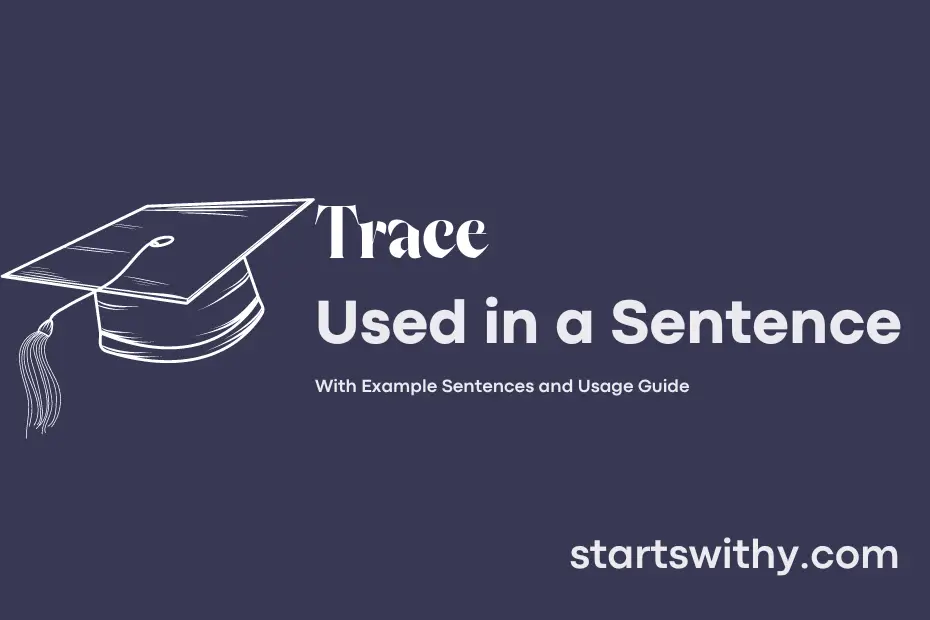Have you ever wondered how to effectively incorporate the word “trace” into your writing? A trace refers to a small amount or indication of something that was previously present or the act of discovering or identifying the origin or location of something.
In writing, using the word “trace” can add depth and detail to your descriptions. Whether you are describing a faint mark, tracking the history of an object, or following the development of a character, incorporating “trace” can bring vivid imagery and context to your work.
7 Examples Of Trace Used In a Sentence For Kids
- Trace the letter “A” on the paper.
- Can you trace the shape of a circle?
- Follow the dots and trace the numbers.
- Use a pencil to trace the cat’s paw.
- Let’s trace the outline of the fish.
- Remember to trace gently so the paper doesn’t tear.
- Practice your writing by tracing these words.
14 Sentences with Trace Examples
- Make sure to trace the path of your academic journey by keeping a record of your grades and achievements.
- It’s important to trace the sources of your research to avoid plagiarism.
- Use a highlighter to trace the key points in your textbooks for quick reference during exams.
- Keep a journal to trace your personal growth and development throughout your college years.
- It’s crucial to trace your expenses to manage your budget effectively as a college student.
- Trace the evolution of your interests and passions by exploring new subjects and activities.
- Utilize online resources to trace the history of your field of study and gain a deeper understanding.
- Trace the steps of a complex mathematical problem to better comprehend the solution process.
- Use a mind map to visually trace the connections between different concepts and theories.
- Create a timeline to trace the major events and milestones in the history of your chosen field.
- Keep a detailed log of your volunteer work to trace your contribution to the community.
- Trace the development of your language skills by practicing reading, writing, and speaking regularly.
- Utilize professional networking platforms to trace the connections you’ve made with industry professionals.
- Develop a personalized study schedule to trace your progress and stay on track with your academic goals.
How To Use Trace in Sentences?
Trace can be used in a sentence as a verb to indicate finding or discovering a sign or evidence of something that was previously present. For example, you could say, “She tried to trace her family’s roots back to their home country.” In this sentence, the word “trace” is used to convey the act of investigating to find the origins of her family.
Another way to use trace is as a noun to describe a mark or sign left by something that has passed through or been in contact with a surface. An example of this would be, “The detective found traces of blood at the crime scene.” Here, the word “traces” is used to reference the small amounts of blood that were left behind.
To further enhance your sentence, you can use trace as an adjective, such as in the sentence, “The team followed the trace amounts of the chemical to locate the leak.” In this instance, “trace” is used to describe the small and barely noticeable amounts of the chemical.
By practicing using trace in different contexts, you can enrich your vocabulary and clearly communicate your thoughts in writing and speaking.
Conclusion
In writing, sentences with the word “trace” are commonly used to describe the act of finding or following something that may be faint or difficult to perceive. These sentences often convey the idea of discovering subtle hints, evidence, or remnants of something previously existing or occurring. For example, “She found a trace of chocolate on the kitchen counter,” or “The detective carefully traced the suspect’s movements through the city.”
Overall, sentences with “trace” evoke the sense of investigation, discovery, and uncovering hidden elements. Whether it’s tracking down a lost item or piecing together a historical event, the use of “trace” in sentences adds a layer of intrigue and pursuit to the narrative.



